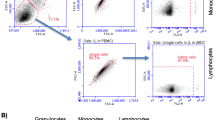Abstract
Innate immune surveillance in the blood is executed mostly by circulating monocytes, which recognize conserved bacterial molecules such as peptidoglycan and lipopolysaccharide. Toll-like receptors (TLR) play a central role in microbe-associated molecular pattern detection. The aim of this study was to compare the differences in TLR expression and cytokine production after stimulation of peripheral blood cells with heat-killed gram-negative and gram-positive human pathogens: Neisseria meningitidis, Escherichia coli, Staphylococcus aureus, and Streptococcus pneumoniae. We found that TLR2 expression is up-regulated on monocytes after stimulation with S. aureus, S. pneumoniae, E. coli, and N. meningitidis. Moreover, TLR2 up-regulation was positively associated with increasing concentrations of gram-positive bacteria, whereas higher concentrations of gram-negative bacteria, especially E. coli, caused a milder TLR2 expression increase when compared to low doses. Cytokines were produced in similar dose-dependent profiles regardless of the stimulatory pathogen; however, gram-negative pathogens induced higher cytokine levels when compared to gram-positive bacteria at the same density. These results indicate that gram-positive and gram-negative bacteria differ in their dose-dependent patterns of induction of TLR2 and TLR4, but not cytokine expression.


Similar content being viewed by others
References
Armstrong L, Medford AR, Hunter KJ, Uppington KM, Millar AB (2004) Differential expression of Toll-like receptor (TLR)-2 and TLR-4 on monocytes in human sepsis. Clin Exp Immunol 136:312–319
Dunzendorfer S, Lee HK, Soldau K, Tobias PS (2004) TLR4 is the signaling but not the lipopolysaccharide uptake receptor. J Immunol 173:1166–1170
Hackett SJ, Guiver M, Marsh J, Sills JA, Thomson AP, Kaczmarski EB, Hart CA (2002) Meningococcal bacterial DNA load at presentation correlates with disease severity. Arch Dis Child 86:44–46
Hellerud BC, Stenvik J, Espevik T, Lambris JD, Mollnes TE, Brandtzaeg P (2008) Stages of meningococcal sepsis simulated in vitro, with emphasis on complement and Toll-like receptor activation. Infect Immun 76:4183–4189
Holub M, Scheinostova M, Dzupova O, Fiserova A, Beran O, Kalmusova J, Musilek M, Krizova P (2007) Neisseria meningitidis strains from patients with invasive meningococcal disease differ in stimulation of cytokine production. Folia Microbiol 52:525–528
Hornef MW, Frisan T, Vandewalle A, Normark S, Richter-Dahlfors A (2002) Toll-like receptor 4 resides in the Golgi apparatus and colocalizes with internalized lipopolysaccharide in intestinal epithelial cells. J Exp Med 195:559–570
Moller AS, Ovstebo R, Haug KB, Joo GB, Westvik AB, Kierulf P (2005) Chemokine production and pattern recognition receptor (PRR) expression in whole blood stimulated with pathogen-associated molecular patterns (PAMPs). Cytokine 32:304–315
Munford RS (2008) Sensing gram-negative bacterial lipopolysaccharides: a human disease determinant? Infect Immun 76:454–465
Nockher WA, Scherberich JE (1995) Monocyte cell-surface CD14 expression and soluble CD14 antigen in hemodialysis: evidence for chronic exposure to LPS. Kidney Int 48:1469–1476
Nomura F, Akashi S, Sakao Y, Sato S, Kawai T, Matsumoto M, Nakanishi K, Kimoto M, Miyake K, Takeda K, Akira S (2000) Cutting edge: endotoxin tolerance in mouse peritoneal macrophages correlates with down-regulation of surface Toll-like receptor 4 expression. J Immunol 164:3476–3479
Rangel-Frausto MS (1999) The epidemiology of bacterial sepsis. Infect Dis Clin North Am 13:299–312
Schaaf B, Luitjens K, Goldmann T, van Bremen T, Sayk F, Dodt C, Dalhoff K, Droemann D (2009) Mortality in human sepsis is associated with downregulation of Toll-like receptor 2 and CD14 expression on blood monocytes. Diagn Pathol 4:12
Sprong T, Netea MG, van der Ley P, Verver-Jansen TJ, Jacobs LE, Stalenhoef A, van der Meer JW, van Deuren M (2004) Human lipoproteins have divergent neutralizing effects on E. coli LPS, N. meningitidis LPS, and complete Gram-negative bacteria. J Lipid Res 45:742–749
Tamandl D, Bahrami M, Wessner B, Weigel G, Ploder M, Furst W, Roth E, Boltz-Nitulescu G, Spittler A (2003) Modulation of Toll-like receptor 4 expression on human monocytes by tumor necrosis factor and interleukin-6: tumor necrosis factor evokes lipopolysaccharide hyporesponsiveness, whereas interleukin-6 enhances lipopolysaccharide activity. Shock 20:224–229
Tsujimoto H, Ono S, Majima T, Efron PA, Kinoshita M, Hiraide H, Moldawer LL, Mochizuki H (2006) Differential Toll-like receptor expression after ex vivo lipopolysaccharide exposure in patients with sepsis and following surgical stress. Clin Immunol 119:180–187
Viemann D, Dubbel G, Schleifenbaum S, Harms E, Sorg C, Roth J (2005) Expression of Toll-like receptors in neonatal sepsis. Pediatr Res 58:654–659
Acknowledgments
This study was supported by the grants IGA NR/9316-3 from the Ministry of Health, Czech Republic, MSM 0021620806 and SVV-2010-260506 from the Ministry of Education, Youth and Sports. The authors thank Dr. Alice Gabrielová (Department of Clinical Microbiology, University Hospital Bulovka, Prague) and Dr. Jitka Kalmusová (National Institute of Public Health, National Reference Laboratory for Meningococcal Infections, Prague) for help with bacterial suspension preparation, and Dr. Robert S. Munford (National Institute of Allergy and Infectious Diseases, National Institutes of Health, Bethesda, MD, USA) for critical review of the manuscript.
Author information
Authors and Affiliations
Corresponding author
Rights and permissions
About this article
Cite this article
Beran, O., Potměšil, R. & Holub, M. Differences in Toll-like receptor expression and cytokine production after stimulation with heat-killed gram-positive and gram-negative bacteria. Folia Microbiol 56, 138–142 (2011). https://doi.org/10.1007/s12223-011-0001-9
Received:
Accepted:
Published:
Issue Date:
DOI: https://doi.org/10.1007/s12223-011-0001-9




